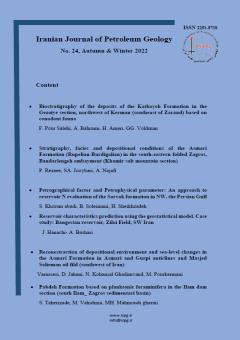Stratigraphy, facies and depositional conditions of the Asmari Formation (Rupelian-Burdigalian) in the south-eastern folded Zagros, Bandarlengeh embayment (Khamir salt mountain section)
Subject Areas : Sedimentology and analysis of sedimentary basins
Peyman Rezaei
1
,
Seyedeh Akram Jooybari
2
![]() ,
Abdullah Najafi
3
,
Abdullah Najafi
3
1 - دانشگاه هرمزگان
2 - PhD in Sedimentology and sedimentary petrology, University of Hormozgan
3 - Master of Sedimentology and sedimentary petrology, University of Hormozgan
Keywords: Asmari formation, sedimentary environment, stratigraphy, Khamir salt mountain, Bandarlengeh embayment,
Abstract :
Asmari Formation (Rupelian-Burdigalian) is one of the most well-known formations in Iran. In order to investigate the stratigraphy and sedimentary environment, a section of this formation was selected in Khamir salt mountain section in Bandarlengeh embayment. In this number, 70 limestone microscopic thin sections and 3 marl samples (XRF) were evaluated to identify the microfacies and the sedimentation conditions.The petrographic study led to the identification of 10 microfacies belonging to the facies belts of tidal, lagoon, carbonate bar, open marine, which were deposited in the homoclinal carbonate ramp environment. The composition of marl facies oxides also indicates the presence of carbonate minerals, quartz and clay minerals, which along with field observations and alternating calcareous facies suggest that this facies was deposited in an open marine environment. Finally, it seems that the facies and fossil diversity of the Asmari Formation in the mentioned section is such that during the Aquitanian stage, this formation was located closer to the coast line and during the Rupelian and Chattian-Burdigalian times, it was located at a further distance from the coast line.
